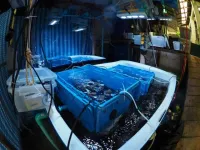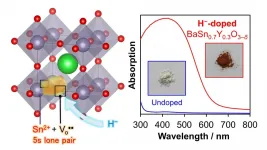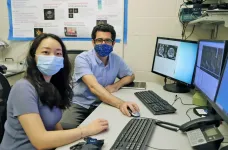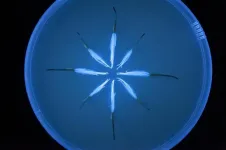With bacteria against coral bleaching
Probiotic approaches could protect corals against heat stress
2021-05-07
(Press-News.org) 7 May 2021/Kiel. Corals are the backbone of marine ecosystems in the tropics. They are threatened by rising water temperatures caused by global warming and they are among the first ecosystems worldwide that are on the verge of ecological collapse. Coral bleaching, which is becoming stronger and more frequent due to heat stress, has already wiped out corals at many locations globally. With the help of a microbiome-targeting strategy developed by an international team led by GEOMAR Helmholtz Centre for Ocean Research Kiel, it could become feasible to help protect corals from heat stress. The work has now been published in the international journal Microbiome.
Corals are the backbone of marine ecosystems in the tropics. They are threatened by rising water temperatures caused by global warming and they are among the first ecosystems worldwide that are on the verge of ecological collapse. Coral bleaching, which is becoming stronger and more frequent due to heat stress, has already wiped out corals at many locations globally. With the help of a microbiome-targeting strategy developed by an international team led by GEOMAR Helmholtz Centre for Ocean Research Kiel, it could become feasible to help protect corals from heat stress. The work has now been published in the international journal Microbiome.
Images of bare, naked white coral reefs have been increasingly circulating around the world. The typically colourful reefs of tropical oceans, which are home to many species of the marine ecosystem, are suffering from rising water temperatures due to global warming. There is no heat relieve for the corals in sight. Scientists are desperately seeking out ways to make the temperature-sensitive organisms more resistant to heat stress. A group of scientists led by GEOMAR Helmholtz Centre for Ocean Research Kiel are developing a promising approach, which is based on a therapeutic treatment known from human medicine. The study was published in the international journal Microbiome.
"The idea is that probiotic bacteria with beneficial functions could help a coral to better withstand heat stress," explains Dr Anna Roik from GEOMAR, lead author of the study, which was funded as part of a Future Ocean Network project at Kiel University. "In the current study, we tested the approach of a 'microbiome transplantation', inspired by microbiome-based applications we know for example from clinical treatments", Roik continues.
The research group conducted coral microbiome transplantation experiments with the reef-building corals Pocillopora and Porites in the Andaman Sea in Thailand. They investigated whether this technique can improve the heat resistance of corals by modifying the bacterial microbiome. The scientists first looked for more heat-tolerant "donor" corals. "We then used material from the coral tissue of the donor corals to inoculate conspecific, heat-sensitive recipients and then documented their bleaching responses and microbiome changes using a genetic analysis method called 16S rRNA gene metabarcoding", explains Dr Roik.
The recipient corals of both species bleached more mildly compared to the control group during a short-term heat stress test (34 °C). "The results show that the inoculated corals were able to resist the heat stress response for a short time", explains Prof. Dr Ute Hentschel Humeida, head of the Marine Symbioses Research Unit at GEOMAR and co-author of the study. "In addition, the microbiome data suggest that the 'inoculated' corals may favour the uptake of putative bacterial symbionts", Dr Anna Roik continues. "However, further experimental studies are required to unravel the exact mechanism of action, as well as long-term field-based studies to test the durability of the effect", says the marine biologist, looking ahead.
INFORMATION:
Scientific paper:
Doering, T., M. Wall, L. Putchim, T. Ratanawongwan, R. Schroeder, U. Hentschel, and A. Roik, 2021: Towards enhancing coral heat tolerance: a "microbiome transplantation" treatment using inoculations of homogenized coral tissues. Microbiome 9, 102, https://doi.org/10.1186/s40168-021-01053-6
Links:
http://annaroik.org/#video1 Video about the publication.
Contact:
Dr. Andreas Villwock (GEOMAR, Communication and Media), Phone: +49 0431 600-2802, presse@geomar.de
[Attachments] See images for this press release:

ELSE PRESS RELEASES FROM THIS DATE:
2021-05-07
Narrow-gap semiconductors with the ability to use visible light have garnered significant interest thanks to their versatility. Now, scientists in Japan have developed and characterized a new semiconductor material for application in process components stimulated by light. The findings have, for the first time, suggested a new way to reduce the band gap in cheaper and non-toxic tin-based oxide semiconductors for efficient light-based applications.
Semiconductors that can exploit the omnipresent visible spectrum of light for different technological applications would serve as a boon to the material world. However, such semiconductors often do not come cheap and can often be toxic. Now, a group of material scientists ...
2021-05-07
May 7, 2021 - Among collegiate football players and other athletes, Black athletes recognize fewer concussion-related symptoms than their White counterparts, reports a study in the May/June issue of the Journal of Head Trauma Rehabilitation (JHTR). The official journal of the Brain Injury Association of America, JHTR is published in the Lippincott portfolio by Wolters Kluwer.
"Despite NCAA concussion education requirements for athletes, Black collegiate-athletes were found to have lower concussion symptom knowledge than White collegiate-athletes," according to the new research by Jessica Wallace, PhD, MPH, LAT, ATC, of University of Alabama, Tuscaloosa, and colleagues. The ...
2021-05-07
RNA-based drugs have the potential to change the standard of care for many diseases, making personalized medicine a reality. This rapidly expanding class of therapeutics are cost-effective, fairly easy to manufacture, and able to go where no drug has gone before, reaching previously undruggable pathways.
Mostly.
So far, these promising drugs haven't been very useful in getting through to the well-protected brain to treat tumors or other maladies.
Now a multi-institutional team of researchers, led by Costas Arvanitis at the Georgia Institute of Technology and Emory University, has figured out a way: using ultrasound and RNA-loaded nanoparticles to get through the protective blood-brain barrier and deliver potent medicine to brain tumors.
"We're able to make this drug more available ...
2021-05-07
Some meat eaters feel disgusted by meat, according to a new study.
University of Exeter scientists showed food pictures to more than 700 people, including omnivores (who eat meat and other foods), flexitarians (who try to eat less meat) and vegetarians.
About 7% of meat eaters (15% of flexitarians and 3% of omnivores) had a "fairly strong disgust response" to images of meat dishes commonly eaten in the UK, like roast chicken or bacon.
As a group, omnivores rated meat images about twice as disgusting on average as pictures of carbohydrate-rich foods like bread, chips and rice.
Based on the findings, the researchers say harnessing the "yuk factor" may ...
2021-05-07
Ikoma, Japan - Many natural compounds have various anti-inflammatory and other beneficial properties that humans have been utilizing for medicinal purposes for hundreds of years. However, the specific molecular mechanisms behind these health-promoting effects are not always clear. One such compound is 1'-acetoxychavicol acetate, or ACA, which comes from the tropical ginger Alpinia plant. Now, researchers from Nara Institute of Science and Technology (NAIST) have identified how ACA can help in the treatment of inflammatory diseases.
In a report published in International Immunology, they found that ACA attenuates mitochondrial damage through decreasing mitochondrial reactive oxygen species (ROS), blocking ...
2021-05-07
Scientists from Nanjing University and University of Macau have discovered nano-scaled apoptotic bodies (ABs) as a new brain-targeting drug carrier, bringing new promise for the Parkinson's Disease as well as other brain diseases.
The blood-brain barrier (BBB) is the most restrictive barrier that keeps most biomolecules and drugs from the brain, setting "barriers" for the treatment of cerebrovascular diseases. With the increasingly serious ageing problem, the treatment of brain diseases now faces tough challenges, and therefore efficient brain drug delivery ...
2021-05-07
Cosmologists have found a way to double the accuracy of measuring distances to supernova explosions - one of their tried-and-true tools for studying the mysterious dark energy that is making the universe expand faster and faster. The results from the Nearby Supernova Factory (SNfactory) collaboration, led by Greg Aldering of the Department of Energy's Lawrence Berkeley National Laboratory (Berkeley Lab), will enable scientists to study dark energy with greatly improved precision and accuracy, and provide a powerful crosscheck of the technique across vast distances ...
2021-05-07
Computer science researchers at the University of Central Florida have developed a sarcasm detector.
Social media has become a dominant form of communication for individuals, and for companies looking to market and sell their products and services. Properly understanding and responding to customer feedback on Twitter, Facebook and other social media platforms is critical for success, but it is incredibly labor intensive.
That's where sentiment analysis comes in. The term refers to the automated process of identifying the emotion -- either positive, negative or neutral -- associated with text. While ...
2021-05-07
Tsukuba, Japan - Scientists from the Faculty of Health and Sports Sciences at the University of Tsukuba used aerodynamics experiments to empirically test the flight properties of a new four-panel soccer ball adopted by the English Premier League this year. Based on projectile and wind-tunnel data, they computed the drag and side forces and found that the new ball was marginally more stable than previous versions but may not fly as far. This work may help improve the design of future sports equipment.
Sports players know that millions of dollars in salary and potential endorsement deals can be at stake during each match. Soccer players often complain about the aerodynamic ...
2021-05-07
Researchers have traced the remaining last steps of the biological pathway that gives oats resistance to the deadly crop disease take-all.
The discovery creates opportunities for new ways of defending wheat and other cereals against the soil-borne root disease.
The research team have already taken the first step in this aim by successfully reconstituting the self-defence system in the model plant Nicotiana benthamiana.
Further experiments to establish the avenacin biosynthetic pathway in wheat's more complex genome, to test if it will provide the same resistance ...
LAST 30 PRESS RELEASES:
[Press-News.org] With bacteria against coral bleaching
Probiotic approaches could protect corals against heat stress







